Mobilized Mohr-Coulomb and Hoek-Brown Strength Parameters during Failure of Granite in Alxa Area in China for High-Level Radioactive Waste Disposal
Abstract
1. Introduction
2. Samples and Experimental Methods
2.1. Samples
2.2. Experimental Methods
3. Experimental Results
- (1)
- For the NRG01 granite samples treated by different temperatures (T = 20 °C, 100 °C and 200 °C), the differential stress – axial strain curves show the similar brittle – ductile transition behaviors with the increasing confining pressures (σ3 = 0–30 MPa);
- (2)
- According to the experimental results, the heat treatment by temperatures no higher than 200 °C does not have very significant influence on the stress – strain curves of the NRG01 granite samples under various confining pressures (σ3 = 0–30 MPa). However, if we make a more careful observation, it can be found that the samples treated by higher temperature show relatively more ductile behavior during the post-peak stage;
- (3)
- The peak strength values are also very close for the samples treated by different temperatures. This means that the heat treatment by temperatures no higher than 200 °C does not have very obvious influence on the strength values of the NRG01 granite samples under various confining pressures (σ3 = 0–30 MPa).
4. Data Analyses and Discussion
4.1. Mobilized Mohr-Coulomb Strength Parameters During Failure of NRG01 Granite
4.1.1. Analytical Method
4.1.2. Data Analyses and Discussion
4.2. Mobilized Hoek-Brown Strength Parameters During Failure of NRG01 Granite
4.2.1. Analytical Method
4.2.2. Data Analyses and Discussion
- (1)
- Similar to the mobilization of cohesion and friction angle, the mobilization of Hoek-Brown strength parameters ( and ) is also non-simultaneous during the failure process of NRG01 granite treated by different temperatures no higher than 200 °C;
- (2)
- With increasing plastic shear strain, increases significantly to a maximum value and then decreases until a residual value;
- (3)
- decreases gradually with the increasing plastic shear strain. This is related to the damage and fracturing process during the tests.
5. Conclusions
- (1)
- Cohesion weakening and friction angle strengthening occurs during the damage and failure process of NRG01 granite samples treated by different temperatures. However, compared with the findings in the previous studies, cohesion decreases in a more gradual manner for NRG01 granite samples, and the friction angle increases immediately to its maximum value before the cohesion approaching to the residual value. This may be owing to the grain size, heterogeneity, or even the hoop effect induced by the cylindrical shape of the samples. More systematic studies are required to make clear the exact influencing factors, as well as the mechanism.
- (2)
- The temperatures of no higher than 200 °C do not have significant influence on the characteristics of mobilized cohesion or friction angle during the damage and failure process of NRG01 granite samples. However, the samples under room temperature (20 °C) have higher initial cohesion than the samples treated by higher temperatures (T=100 °C and 200 °C). In addition, the samples treated by temperature of 200 °C have higher friction angle than the samples treated by lower temperatures. This should be caused by the cracks induced by the heat treatment.
- (3)
- The Hoek-Brown strength parameters and are also observed to show non-simultaneous mobilization behaviors during the failure process of NRG01 granite samples treated by different temperatures. It is found that increases significantly to a maximum value and then decreases until a residual value, and decreases gradually with the increasing plastic shear strain. The general characteristics of the mobilized and are similar for NRG01 granite samples treated by different temperatures, and the fitted equations for modelling the mobilization of both parameters are proposed. The samples treated by temperature of 200 °C have higher initial value, this should also be caused by the cracks induced by the heat treatment.
Author Contributions
Funding
Acknowledgments
Conflicts of Interest
References
- Cheng, C.; Li, X.; Li, S.; Zheng, B. Geomechanical studies on granite intrusions in alxa area for high-level radioactive waste disposal. Sustainability 2016, 8, 1329. [Google Scholar] [CrossRef]
- Cheng, C.; Li, X.; Li, S.; Zheng, B. Failure behavior of granite affected by confinement and water pressure and its influence on the seepage behavior by laboratory experiments. Materials 2017, 10, 798. [Google Scholar] [CrossRef] [PubMed]
- Zhao, X.G.; Wang, J.; Cai, M.; Ma, L.K.; Zong, Z.H.; Wang, X.Y.; Su, R.; Chen, W.M.; Zhao, H.G.; Chen, Q.C.; et al. In-situ stress measurements and regional stress field assessment of the Beishan Area, China. Eng. Geol. 2013, 163, 26–40. [Google Scholar] [CrossRef]
- Zhao, X.G.; Wang, J.; Qin, X.H.; Cai, M.; Su, R.; He, J.G.; Zong, Z.H.; Ma, L.K.; Ji, R.L.; Zhang, M.; et al. In-situ stress measurements and regional stress field assessment in the Xinjiang candidate area for China’s HLW disposal. Eng. Geol. 2015, 197, 42–56. [Google Scholar] [CrossRef]
- Martin, C.D.; Read, R.S.; Martino, J.B. Observations of brittle failure around a circular test tunnel. Int. J. Rock Mech. Min. Sci. 1997, 34, 1065–1073. [Google Scholar] [CrossRef]
- Read, R.S. 20 years of excavation response studies at AECL’s underground research laboratory. Int. J. Rock Mech. Min. Sci. 2004, 41, 1251–1275. [Google Scholar] [CrossRef]
- IAEA. Geological Disposal of Radioactive Waste: Technological Implications for Retrievability; IAEA Nuclear Energy Series No. NW-T-1.19; International Atomic Energy Agency: Vienna, Austria, 2009; Available online: http://www-pub.iaea.org/MTCD/publications/PDF/Pub1378_web.pdf (accessed on 30 September 2019).
- Pusch, R. Geological Storage of Highly Radioactive Waste; Springer: Berlin/Heidelberg, Germany, 2009. [Google Scholar]
- Hudson, J.A. Underground radio active waste disposal: The rock mechanics contribution. In ISRM International Symposium—6th Asian Rock Mechanics Symposium; Sharma, K.G., Ramamurthy, T., Kanjlia, V.K., Gupta, A.C., Eds.; International Society for Rock Mechanics: New Delhi, India, 2010; pp. 3–20. [Google Scholar]
- Wang, J. High-level radioactive waste disposal in china: Update 2010. J. Rock Mech. Geotech. Eng. 2010, 2, 1–11. [Google Scholar]
- Chijimatsu, M.; Nguyen, T.S.; Jing, L.; De Jonge, J.; Kohlmeier, M.; Millard, A.; Rejeb, A.; Rutqvist, J.; Souley, M.; Sugita, Y. Numerical study of the thm effects on the near-field safety of a hypothetical nuclear waste repository—bmt1 of the decovalex iii project. Part 1: Conceptualization and characterization of the problems and summary of results. Int. J. Rock Mech. Min. Sci. 2005, 42, 720–730. [Google Scholar] [CrossRef]
- Bond, A.N.C.; Fedors, R.; Lang, P.; McDermott, C.; Neretnieks, I.; Pan, P.; Šembera, J.; Watanabe, N.; Yasuhara, H. Coupled THMC modelling of a single fracture in novaculite for DECOVALEX-2015. In Proceedings of the DFNE2014, Vancouver, BC, Canada, 19–22 October 2014. [Google Scholar]
- Chen, L.; Wang, C.P.; Liu, J.F.; Liu, J.; Wang, J.; Jia, Y.; Shao, J.F. Damage and plastic deformation modeling of beishan granite under compressive stress conditions. Rock Mech. Rock Eng. 2015, 48, 1623–1633. [Google Scholar] [CrossRef]
- Zhao, X.G.; Wang, J.; Chen, F.; Li, P.F.; Ma, L.K.; Xie, J.L.; Liu, Y.M. Experimental investigations on the thermal conductivity characteristics of Beishan granitic rocks for China’s HLW disposal. Tectonophysics 2016, 683, 124–137. [Google Scholar] [CrossRef]
- Zhao, X.G.; Zhao, Z.; Guo, Z.; Cai, M.; Li, X.; Li, P.F.; Chen, L.; Wang, J. Influence of thermal treatment on the thermal conductivity of Beishan granite. Rock Mech. Rock Eng. 2018, 51, 2055–2074. [Google Scholar] [CrossRef]
- Xue, D.; Zhou, H.; Zhao, Y.; Zhang, L.; Deng, L.; Wang, X. Real-time sem observation of mesoscale failures under thermal-mechanical coupling sequences in granite. Int. J. Rock Mech. Min. Sci. 2018, 112, 35–46. [Google Scholar] [CrossRef]
- Chen, L.; Wang, J.; Zong, Z.; Liu, J.; Su, R.; Guo, Y.; Jin, Y.; Chen, W.; Ji, R.; Zhao, H. A new rock mass classification system QHLW for high-level radioactive waste disposal. Eng. Geol. 2015, 190, 33–51. [Google Scholar] [CrossRef]
- Kim, J.-S.; Kwon, S.-K.; Sanchez, M.; Cho, G.-C. Geological storage of high level nuclear waste. KSCE J. Civ. Eng. 2011, 15, 721–737. [Google Scholar] [CrossRef]
- Zhao, X.G.; Wang, J.; Cai, M.; Cheng, C.; Ma, L.K.; Su, R.; Zhao, F.; Li, D.J. Influence of unloading rate on the strainburst characteristics of Beishan granite under true-triaxial unloading conditions. Rock Mech. Rock Eng. 2013, 47, 467–483. [Google Scholar] [CrossRef]
- Wang, J. On area-specific underground research laboratory for geological disposal of high-level radioactive waste in China. J. Rock Mech. Geotech. Eng. 2014, 6, 99–104. [Google Scholar] [CrossRef]
- Marschall, P.; Giger, S.; De La Vassière, R.; Shao, H.; Leung, H.; Nussbaum, C.; Trick, T.; Lanyon, B.; Senger, R.; Lisjak, A.; et al. Hydro-mechanical evolution of the edz as transport path for radionuclides and gas: Insights from the Mont Terri rock laboratory (Switzerland). Swiss J. Geosci. 2017, 110, 173–194. [Google Scholar] [CrossRef]
- Wang, J.; Chen, L.; Su, R.; Zhao, X. The Beishan underground research laboratory for geological disposal of high-level radioactive waste in china: Planning, site selection, site characterization and in situ tests. J. Rock Mech. Geotech. Eng. 2018, 10, 411–435. [Google Scholar] [CrossRef]
- Alonso, E.; Alejano, L.R.; Varas, F.; Fdez-Manin, G.; Carranza-Torres, C. Ground response curves for rock masses exhibiting strain-softening behaviour. Int. J. Numer. Anal. Methods Geomech. 2003, 27, 1153–1185. [Google Scholar] [CrossRef]
- Lee, Y.-K.; Pietruszczak, S. A new numerical procedure for elasto-plastic analysis of a circular opening excavated in a strain-softening rock mass. Tunn. Undergr. Space Technol. 2008, 23, 588–599. [Google Scholar] [CrossRef]
- Jianxin, H.; Shucai, L.; Shuchen, L.; Lei, W. Post-peak stress-strain relationship of rock mass based on hoek-brown strength criterion. Procedia Earth Planet. Sci. 2012, 5, 289–293. [Google Scholar] [CrossRef]
- Hajiabdolmajid, V.; Kaiser, P.K.; Martin, C.D. Modelling brittle failure of rock. Int. J. Rock Mech. Min. Sci. 2002, 39, 731–741. [Google Scholar] [CrossRef]
- Zhao, X.G.; Cai, M. A mobilized dilation angle model for rocks. Int. J. Rock Mech. Min. Sci. 2010, 47, 368–384. [Google Scholar] [CrossRef]
- Vermeer, P.A.; De Borst, R. Non-associated plasticity for soils, concrete and rock. HERON 1984, 29, 163–196. [Google Scholar]
- Hajiabdolmajid, V.R. Mobilization of strength in brittle failure of rock. Géotechnique 2003, 53, 327–336. [Google Scholar] [CrossRef]
- Guo, S.; Qi, S.; Zhan, Z.; Zheng, B. Plastic-strain-dependent strength model to simulate the cracking process of brittle rocks with an existing non-persistent joint. Eng. Geol. 2017, 231, 114–125. [Google Scholar] [CrossRef]
- Rafiei Renani, H.; Martin, C.D. Cohesion degradation and friction mobilization in brittle failure of rocks. Int. J. Rock Mech. Min. Sci. 2018, 106, 1–13. [Google Scholar] [CrossRef]
- Schmertmann, J.H.; Osterberg, J.O. An Experimental Study of the Development of Cohesion and Friction with Axial Strain in Saturated Cohesive Soils; Research Conference on Shear Strength of Cohesive Soils; ASCE: Reston, VA, USA, 1960; pp. 643–694. [Google Scholar]
- Walton, G.; Arzúa, J.; Alejano, L.R.; Diederichs, M.S. A laboratory-testing-based study on the strength, deformability, and dilatancy of carbonate rocks at low confinement. Rock Mech. Rock Eng. 2015, 48, 941–958. [Google Scholar] [CrossRef]
- Martin, C.D. The Strength of Massive Lac du Bonnet Grantie Around Underground Openings; University of Manitoba: Winnipeg, MB, Canada, 1993. [Google Scholar]
- Martin, C.D.; Chandler, N.A. The progressive fracture of lac du bonnet granite. Int. J. Rock Mech. Min. Sci. Geomech. Abstr. 1994, 31, 643–659. [Google Scholar] [CrossRef]
- Hajiabdolmajid, V.R. Mobilization of Strength in Brittle Failure of Rock; Queen’s University: Kingston, ON, Canada, 2001. [Google Scholar]
- Edelbro, C. Numerical modelling of observed fallouts in hard rock masses using an instantaneous cohesion-softening friction-hardening model. Tunn. Undergr. Space Technol. 2009, 24, 398–409. [Google Scholar] [CrossRef]
- Barton, N.; Pandey, S.K. Numerical modelling of two stoping methods in two indian mines using degradation of c and mobilization of φ based on q-parameters. Int. J. Rock Mech. Min. Sci. 2011, 48, 1095–1112. [Google Scholar] [CrossRef]
- Walton, G.; Diederichs, M.; Punkkinen, A.; Whitmore, J. Back analysis of a pillar monitoring experiment at 2.4km depth in the Sudbury Basin, Canada. Int. J. Rock Mech. Min. Sci. 2016, 85, 33–51. [Google Scholar] [CrossRef]
- Walton, G. Initial guidelines for the selection of input parameters for cohesion-weakening-friction-strengthening (CWFS) analysis of excavations in brittle rock. Tunn. Undergr. Space Technol. 2019, 84, 189–200. [Google Scholar] [CrossRef]
- Hoek, E.; Carranza-Torres, C.; Corkum, B. Hoek-Brown failure criterion. Proc. NARMS 2002, 1, 267–273. [Google Scholar]
- Hoek, E.; Brown, E.T. The Hoek—Brown Failure Criterion and GSI. J. Rock Mech. Geotech. Eng. 2019, 11, 445–463. [Google Scholar] [CrossRef]
- David, E.C.; Brantut, N.; Schubnel, A.; Zimmerman, R.W. Sliding crack model for nonlinearity and hysteresis in the uniaxial stress–strain curve of rock. Int. J. Rock Mech. Min. Sci. 2012, 52, 9–17. [Google Scholar] [CrossRef]
- Zhao, X.G.; Cai, M.; Wang, J.; Li, P.F. Strength comparison between cylindrical and prism specimens of Beishan granite under uniaxial compression. Int. J. Rock Mech. Min. Sci. 2015, 76, 10–17. [Google Scholar] [CrossRef]
- Song, F.; Dong, Y.-H.; Xu, Z.-F.; Zhou, P.-P.; Wang, L.-H.; Tong, S.-Q.; Duan, R.-Q. Granite microcracks: Structure and connectivity at different depths. J. Asian Earth Sci. 2016, 124, 156–168. [Google Scholar] [CrossRef]
- Shi, X. The Tectonic Affinity of the Zongnaishan-Shalazhashan Zone in Northern Alxa and Its Implications: Evidence from Intrusive and Metamorphic Rocks. Ph.D. Thesis, Chinese Academy of Geological Sciences, Beijing, China, 2015. (In Chinese). [Google Scholar]
- Zhou, J.; Lan, H.; Zhang, L.; Yang, D.; Song, J.; Wang, S. Novel grain-based model for simulation of brittle failure of Alxa porphyritic granite. Eng. Geol. 2019, 251, 100–114. [Google Scholar] [CrossRef]
- Chen, L.; Liu, J.; Wang, C.; Wang, X.; Su, R.; Wang, J.; Shao, J. Elastoplastic damage model of beishan deep granite. Yanshilixue Yu Gongcheng Xuebao/Chin. J. Rock Mech. Eng. 2013, 32, 289–298. [Google Scholar]
- Guo, R. Coupled Thermal-Mechanical Modelling of a Deep Geological Repository Using the Horizontal Tunnel Placement Method in Sedimentary Rock Using Code_Bright; Report NWMO TR-2010-22; Nuclear Waste Management Organization: Toronto, ON, Canada, 2010; p. 54. Available online: https://www.nwmo.ca/~/media/Site/Reports/2015/09/24/05/33/1695_nwmotr-2010-22horizontal-tunnel-placmentmethod_limestone_r0b_worddocument.ashx?la=en (accessed on 30 September 2019).
- Ikonen, K. Thermal Analyses of Spent Nuclear Fuel Repository; POSIVA 2003-04; Posiva: Eurajoki, Finland, 2003; p. 61. Available online: http://www.posiva.fi/files/1018/Posiva_2003-04.pdf (accessed on 30 September 2019).
- Rutqvist, J.; Chijimatsu, M.; Jing, L.; Millard, A.; Nguyen, T.S.; Rejeb, A.; Sugita, Y.; Tsang, C.F. A numerical study of thm effects on the near-field safety of a hypothetical nuclear waste repository—bmt1 of the decovalex iii project. Part 3: Effects of thm coupling in sparsely fractured rocks. Int. J. Rock Mech. Min. Sci. 2005, 42, 745–755. [Google Scholar] [CrossRef]
- Weetjens, E. Update of the Near Field Temperature Evolution Calculations for Disposal of UNE-55, MOX-50 and Vitrified HLW in a Supercontainer-Based Geological Repository; SCK·CEN-ER-86; Belgian Nuclear Research Centre: Mol, Belgium, 2009; p. 14. [Google Scholar]
- Gajewski, M.; Jemioło, S. The influence of pavement degradation caused by cyclic loading on its failure mechanisms. Balt. J. Road Bridge Eng. 2016, 11, 179–187. [Google Scholar] [CrossRef]
- Walton, G.; Diederichs, M.S. A new model for the dilation of brittle rocks based on laboratory compression test data with separate treatment of dilatancy mobilization and decay. Geotech. Geol. Eng. 2015, 33, 661–679. [Google Scholar] [CrossRef]
- Walton, G.; Alejano, L.R.; Arzua, J.; Markley, T. Crack damage parameters and dilatancy of artificially jointed granite samples under triaxial compression. Rock Mech. Rock Eng. 2018, 51, 1637–1656. [Google Scholar] [CrossRef]
- Hoek, E. Strength of jointed rock masses. Geotechnique 1983, 33, 187–223. [Google Scholar] [CrossRef]
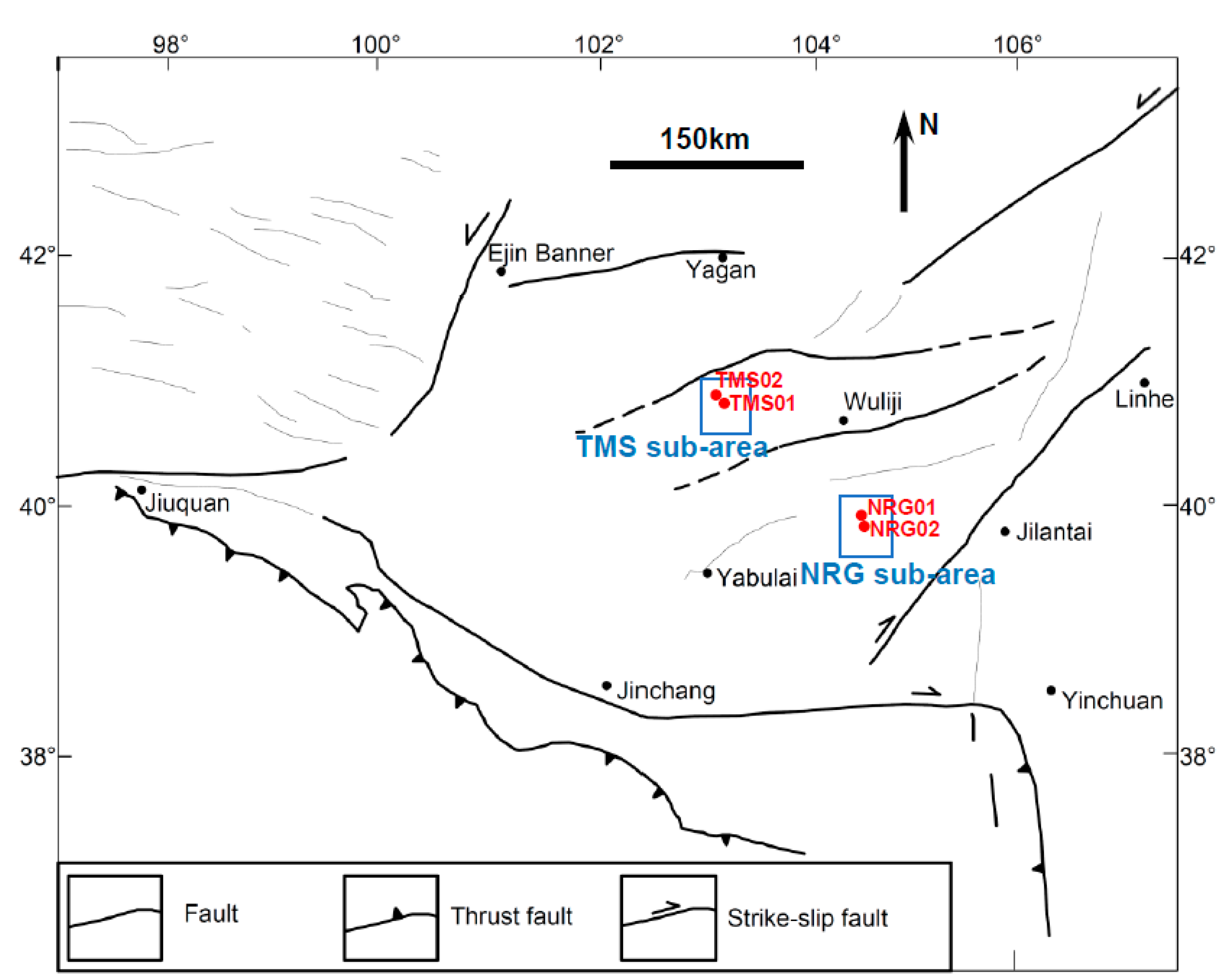
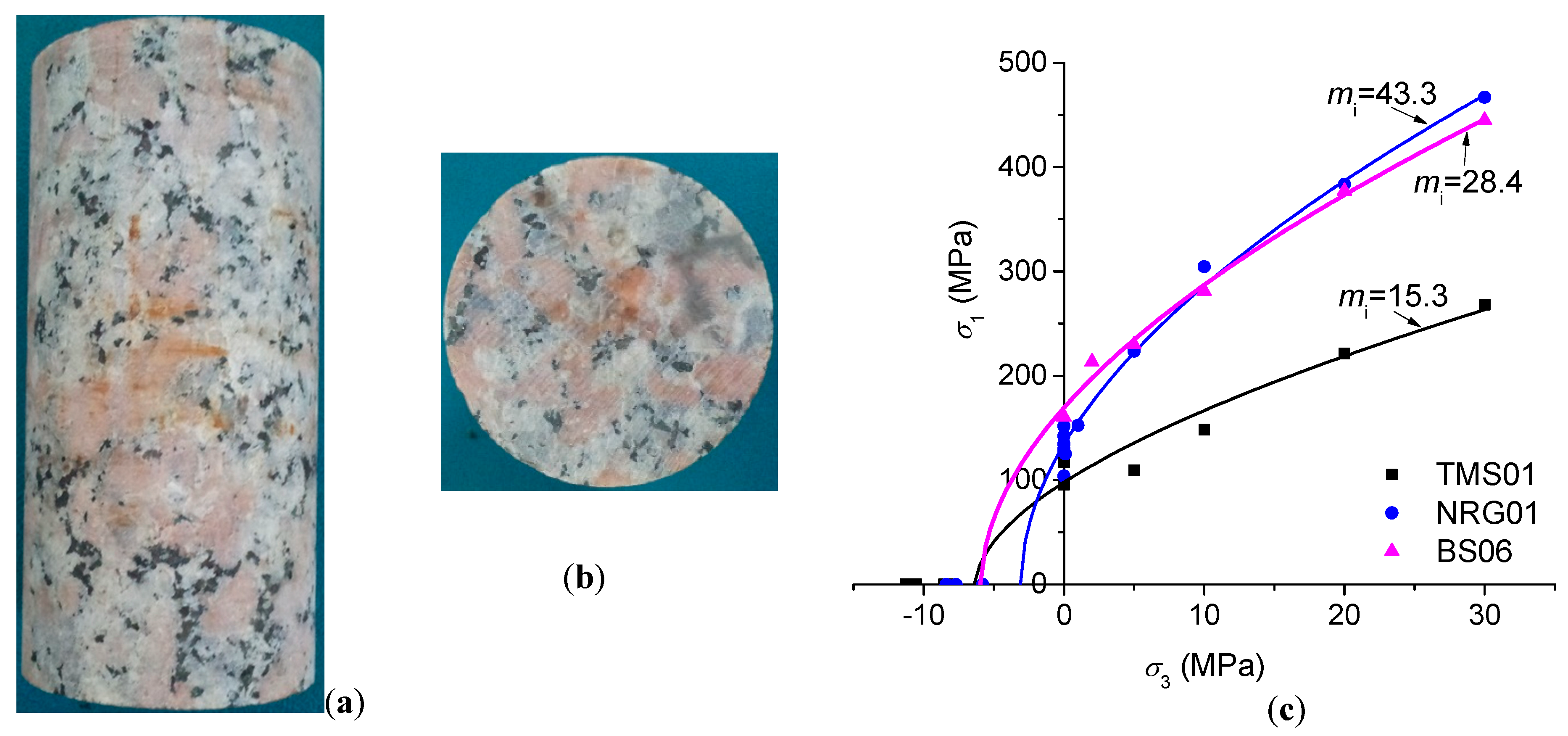
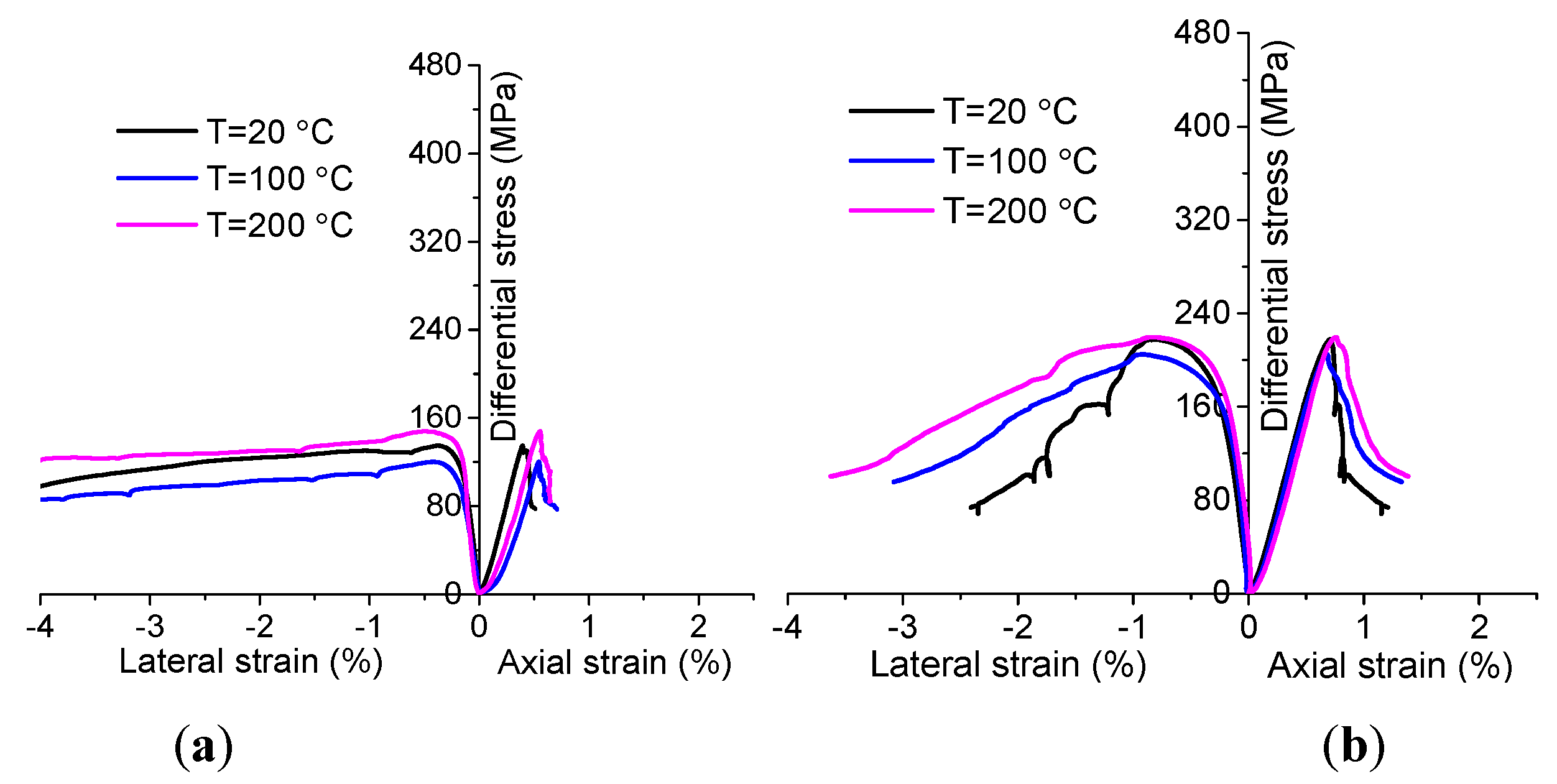
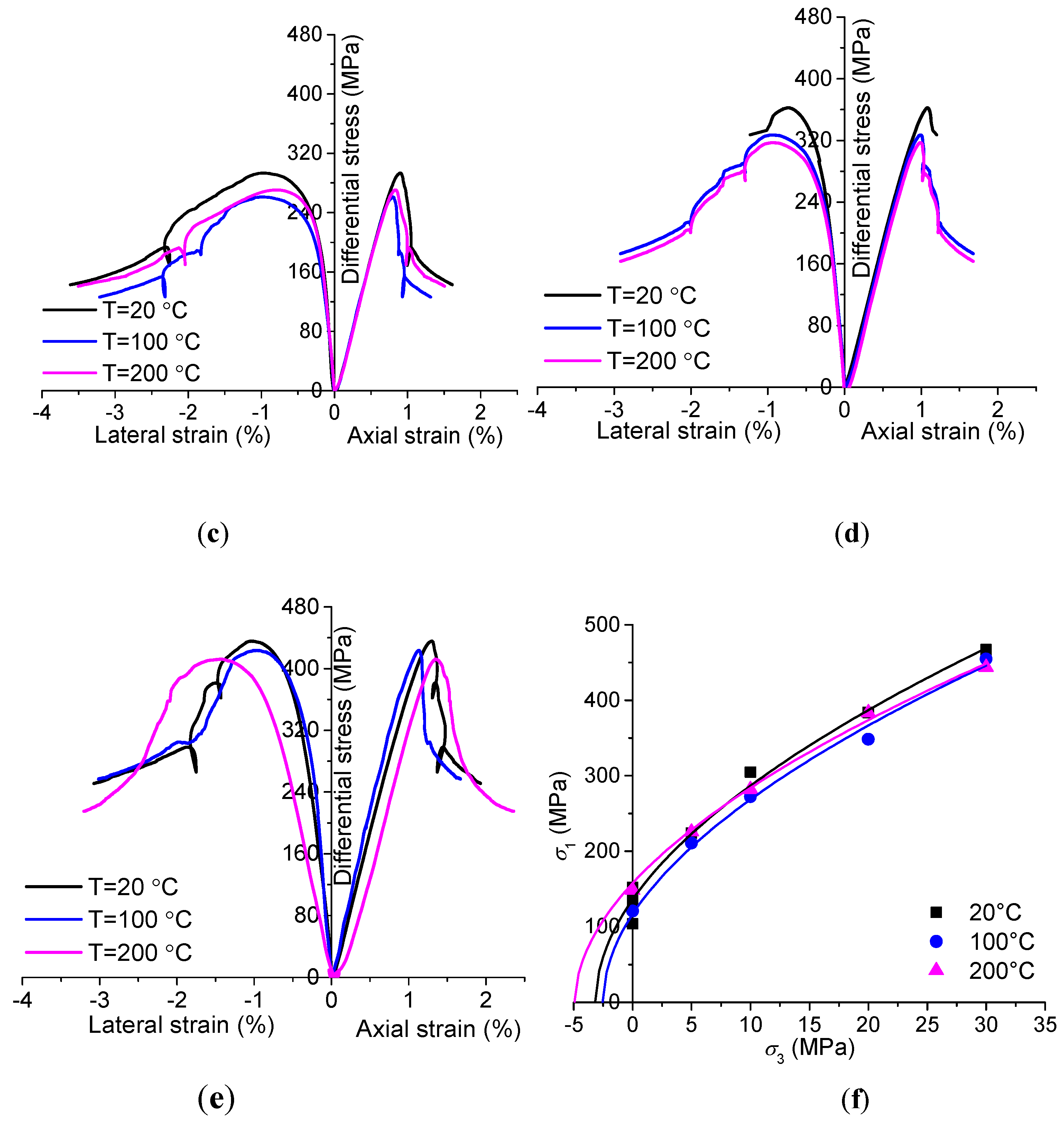
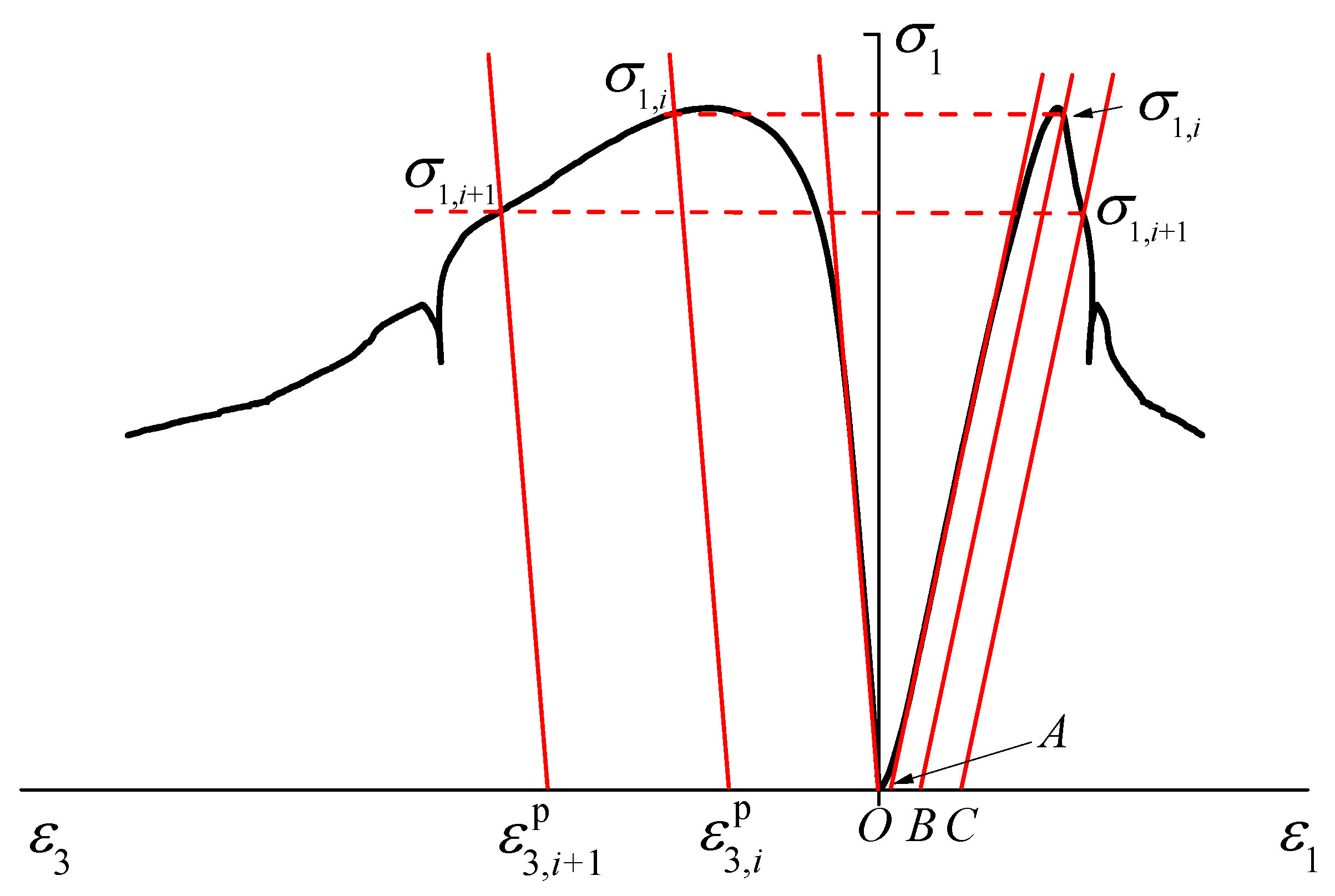
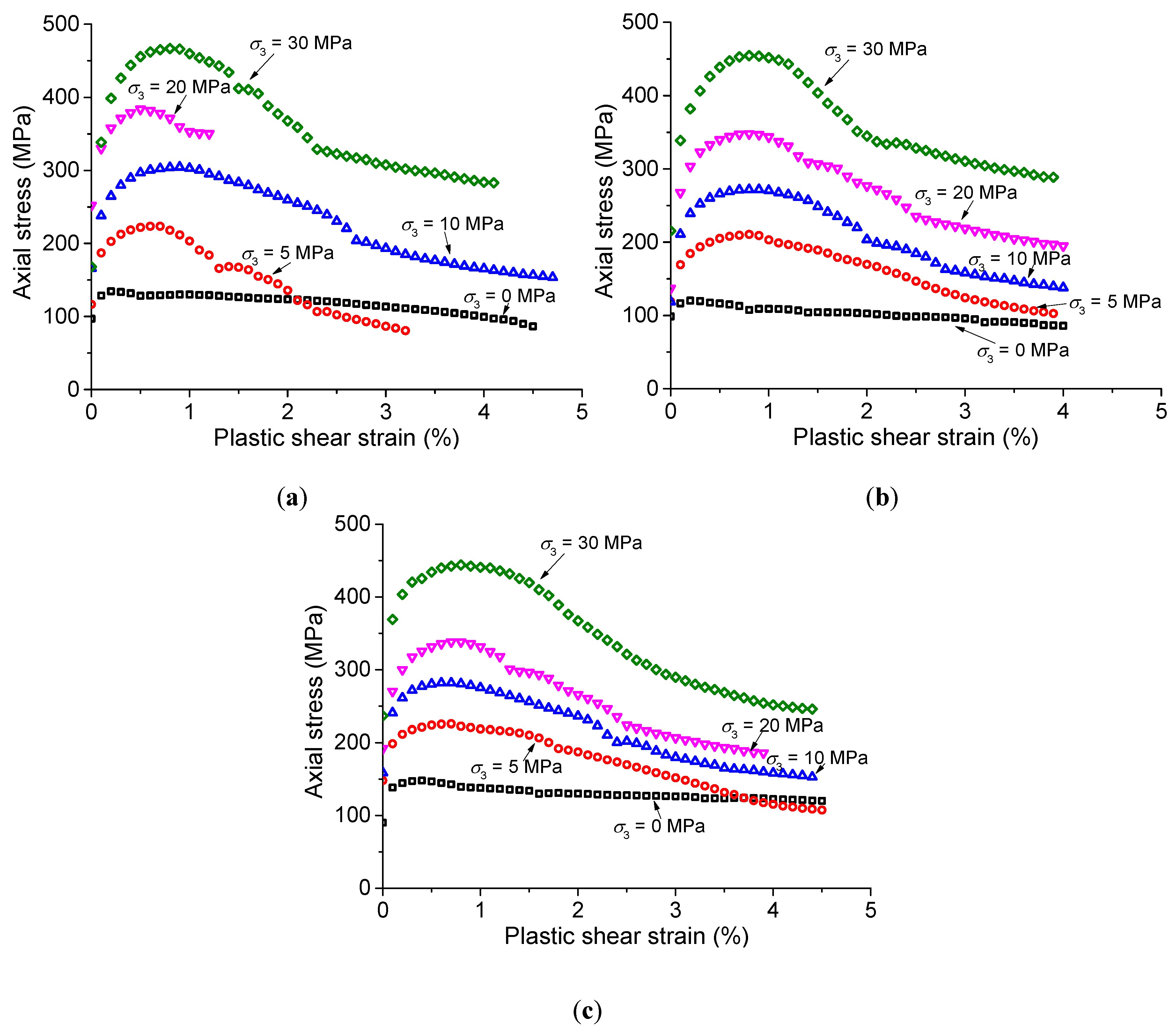
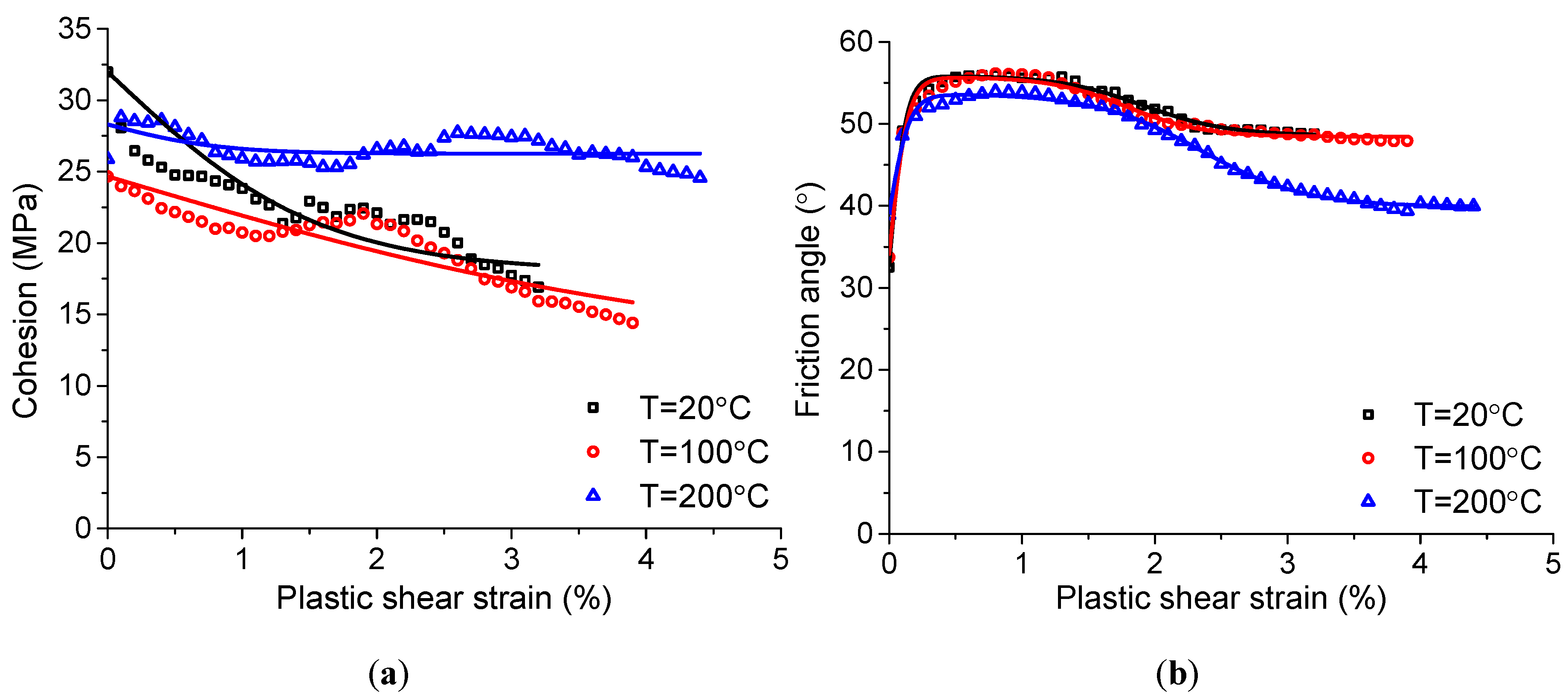

| Minerals | Contents | Grain Sizes (mm) |
|---|---|---|
| alkali feldspar | 45% | 2.0–8.0 |
| plagioclase | 18% | 1.3–3.0 |
| quartz | 25% | 1.5–4.0 |
| biotite | 12% | 0.8–1.5 |
| NO. | Length (mm) | Diameter (mm) | Density (g/mm3) | Confinement (MPa) | Temperature (°C) |
|---|---|---|---|---|---|
| N1-20 | 100.17 | 49.55 | 2.64 | 0 | 20 |
| N1-14 | 100.13 | 49.51 | 2.65 | 5 | 20 |
| N1-29 | 99.67 | 49.99 | 2.63 | 10 | 20 |
| N1-7 | 100.31 | 49.99 | 2.65 | 20 | 20 |
| N1-23 | 100.09 | 49.46 | 2.64 | 5 | 20 |
| N1-77 | 100.39 | 50.17 | 2.63 | 0 | 100 |
| N1-83 | 100.32 | 50.03 | 2.63 | 5 | 100 |
| N1-85 | 100.15 | 50.02 | 2.65 | 10 | 100 |
| N1-88 | 100.28 | 50.14 | 2.64 | 20 | 100 |
| N1-92 | 100.45 | 50.11 | 2.64 | 30 | 100 |
| N1-79 | 100.49 | 50.21 | 2.65 | 0 | 200 |
| N1-82 | 100.32 | 49.74 | 2.64 | 5 | 200 |
| N1-87 | 100.37 | 50.13 | 2.63 | 10 | 200 |
| N1-89 | 100.45 | 49.72 | 2.64 | 20 | 200 |
| N1-93 | 98.79 | 50.14 | 2.65 | 30 | 200 |
| Temperature (°C) | ||||||||||
|---|---|---|---|---|---|---|---|---|---|---|
| 20 | 31.99 | 18.00 | 3.93 | 0.6696 | 32.78 | 55.91 | 48.58 | 0.31 | 3.52 | 0.9864 |
| 100 | 24.67 | 12.00 | 11.35 | 0.8341 | 34.14 | 55.74 | 48.43 | 0.35 | 3.23 | 0.9746 |
| 200 | 28.31 | 26.26 | 2.08 | 0.2001 | 39.21 | 53.70 | 39.89 | 0.38 | 4.3 | 0.9931 |
| T (°C) 1 | |||||||||||
|---|---|---|---|---|---|---|---|---|---|---|---|
| 20 | 4.64 | 12.40 | 43.71 | 0.56 | 3.65 | 0.9947 | 1.00 | −1.00 | 8.15 | 1.72 | 0.9751 |
| 100 | 4.68 | 13.98 | 45.64 | 0.72 | 3.53 | 0.9868 | 1.00 | 0.45 | 1.80 | 2.00 | 0.9464 |
| 200 | 8.54 | 4.09 | 43.08 | 0.52 | 4.09 | 0.9940 | 1.00 | 0.63 | 1.41 | 1.70 | 0.9860 |
© 2019 by the authors. Licensee MDPI, Basel, Switzerland. This article is an open access article distributed under the terms and conditions of the Creative Commons Attribution (CC BY) license (http://creativecommons.org/licenses/by/4.0/).
Share and Cite
Cheng, C.; Xu, N.; Zheng, B. Mobilized Mohr-Coulomb and Hoek-Brown Strength Parameters during Failure of Granite in Alxa Area in China for High-Level Radioactive Waste Disposal. Energies 2019, 12, 4237. https://doi.org/10.3390/en12224237
Cheng C, Xu N, Zheng B. Mobilized Mohr-Coulomb and Hoek-Brown Strength Parameters during Failure of Granite in Alxa Area in China for High-Level Radioactive Waste Disposal. Energies. 2019; 12(22):4237. https://doi.org/10.3390/en12224237
Chicago/Turabian StyleCheng, Cheng, Nengxiong Xu, and Bo Zheng. 2019. "Mobilized Mohr-Coulomb and Hoek-Brown Strength Parameters during Failure of Granite in Alxa Area in China for High-Level Radioactive Waste Disposal" Energies 12, no. 22: 4237. https://doi.org/10.3390/en12224237
APA StyleCheng, C., Xu, N., & Zheng, B. (2019). Mobilized Mohr-Coulomb and Hoek-Brown Strength Parameters during Failure of Granite in Alxa Area in China for High-Level Radioactive Waste Disposal. Energies, 12(22), 4237. https://doi.org/10.3390/en12224237





